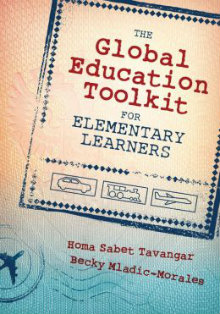Tools to Bring the World to Your Classroom
The Global Education Toolkit for Elementary Learners
By Homa Sabet Tavangar and Becky Mladic-Morales
(Corwin Publications, 2014 – Learn more)

Today’s children are in need of what we educators call 21st century skills. An awareness of the world around them and the global connectedness surrounding us in everyday situations is necessary and vital to the success of tomorrow’s adults.

The Global Education Toolkit for Elementary Learners is organized in chapters providing a multitude of resources. Chapters can be read alone, or together, depending on you and your students’ needs/desires.
- The introduction explains exactly how and why to use the book.
- Chapter 1 provides information on how to bring global aspects to your school.
- Chapter 2 is a stand-alone resource of over 50 global ideas and activities that can be implemented right away in any classroom.
- Chapter 3 focuses on alignment of the Common Core Standards to global learning in various subject areas and themes. Examples of lessons are provided.
- Chapter 4 exposes digital tools to harness classroom global relationships with people, places, and ideas, as well as enhance your own professional development.
- Chapter 5 is a plethora of resources on how to start your own school club, initiative, or philanthropic service for a global need near or far.
As a teacher who began the global journey just two short years ago through student blogging, this book caught my eye as a way to help develop what I have started in the classroom into something more meaningful and impactful. To further facilitate those much needed 21st century skills for my students.
User friendly global access
If you are an educator looking to bring what you are already doing in your classroom to the next level, or to just to get started with a simple way to connect your students globally, this book is for you, whether you teach elementary, middle or high school. I can confidently say this book is a better tool than Google, Twitter, Pinterest, and similar tools when it comes to finding resources for global education. (Contained in the text are words highlighted in blue. When you access the digital form of the book, you are able to click on the highlighted words as an added resource.)
The past two years I have been involved in the Global Read Aloud project (also in this book), which allows classrooms all over the world to be connected through a common book reading experience. To extend the learning, I plan on implementing a photo exchange with an international class we connect with during the Global Read Aloud project.
The pictures focus on how water, food, energy, and plastic are used in the different communities. The photo exchange project allows students to compare usage and relate it to their Science and Common Core Standards. This project is one of the many I plan on using next school year to enhance our learning experiences. The Toolkit will be a valuable project booster.
In a world connected globally more now than ever, it is our job to prepare our students for this connected world. The Global Education Toolkit for Elementary Learners is a “one-stop shopping” book well worth your time and money. Administrators, teachers, PTA members, and/or school volunteers looking for a meaningful guide to successfully implement any global project, big or small, will find what they need in Tavangar and Mladic-Morales’ excellent guide.
Jennifer Druffel (@MrsDruffel) is a fifth grade teacher in Spokane Valley, WA. She is endorsed in Elementary Education and K-12 Reading Instruction. She engages students through authentic experiences such as genius hour and blogging at MrsDruffelsClass-2. Being naturally driven to always better her practice and inspire her students fuels her research and connectedness as an educator. Follow her at jendruffel.wordpress.com



































